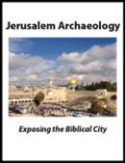
2016 was the golden anniversary of Israeli archaeologist Michael Avi-Yonah’s model of Herod’s Temple. The model, originally commissioned for the Holy Land Hotel in Jerusalem and part of a much larger model of ancient Jerusalem, is now housed in the Israel Museum. Photo: Steven Fine.
The year 2016 marked the 50th anniversary of the now-iconic model of Herod’s Temple created by Israeli historian and archaeologist Michael Avi-Yonah. The model, completed in 1966 after four years of construction, was commissioned by Hans Kroch of the Holy Land Hotel in Jerusalem. After 40 years at the hotel, in 2006 the model was restored and moved to its current home at the Israel Museum.
The model of Herod’s Temple is part of a larger model of ancient Jerusalem. It depicts Jerusalem as it was before the Romans destroyed the city—and Herod’s Temple—in 70 C.E. during the First Jewish Revolt against Rome. But just how accurate is the model? In “A Temple’s Golden Anniversary” in the January/February 2016 issue of Biblical Archaeology Review, Peter J. Schertz and Steven Fine discuss this tantalizing question.
Michael Avi-Yonah used both textual and archaeological sources—including Josephus’s writings, the New Testament, later Rabbinic sources and depictions on artifacts such as Jewish revolt coins, as well as his own extensive knowledge of Herodian, Near Eastern and Roman architectural styles—to create a “highly fanciful and also highly probable” model of Herod’s Temple.

As with any reconstruction of a long destroyed ancient building, especially one as important as Herod’s Temple, many complications surround Michael Avi-Yonah’s model. Josephus describes Herod’s Temple extensively in his Jewish War and Antiquities of the Jews, but each description differs slightly, and neither allows for easy architectural reconstruction. Other elements of Josephus’s descriptions, such as the height of the Temple gate doors—which Josephus lists at 49 feet high and 24.5 feet wide—could be exaggerated, as Josephus was wont to do. However, doors of this size were known to exist in the ancient world. Two examples can be found in Rome itself: at the Pantheon and at the Senate House in the Roman Forum. Thus, Avi-Yonah’s model of Herod’s Temple stays true to Josephus’s description. This is but one of the decisions Avi-Yonah had to make concerning his representation of Herod’s Temple.
Become a Member of Biblical Archaeology Society Now and Get More Than Half Off the Regular Price of the All-Access Pass!
Explore the world’s most intriguing Biblical scholarship
Dig into more than 9,000 articles in the Biblical Archaeology Society’s vast library plus much more with an All-Access pass.

What are some of the other controversies and complications surrounding Herod’s Temple model? For the answer to this question and more, read the full article “A Temple’s Golden Anniversary” by Peter J. Schertz and Steven Fine as it appears in the January/February 2016 issue of BAR.
BAS Library Members: Read the full article “A Temple’s Golden Anniversary” by Peter J. Schertz and Steven Fine in the January/February 2016 issue of Biblical Archaeology Review.Not a BAS Library or All-Access Member yet? Join today.
This Bible History Daily feature was originally published on January 10, 2016.
Learn more about Herod’s Temple in Jerusalem in Bible History Daily:
The post What Did Herod’s Temple in Jerusalem Look Like? appeared first on Biblical Archaeology Society.


0 Commentaires